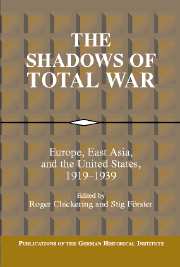Book contents
- Frontmatter
- Introduction
- Part One Reflections on the Interwar Period
- 1 The Politics of War and Peace in the 1920s and 1930s
- 2 War and Society in the 1920s and 1930s
- 3 Plans, Weapons, Doctrines: The Strategic Cultures of Interwar Europe
- Part Two Legacies of the Great War
- Part Three Visions of the Next War
- Part Four Projections and Practice
- Index
2 - War and Society in the 1920s and 1930s
Published online by Cambridge University Press: 05 January 2013
- Frontmatter
- Introduction
- Part One Reflections on the Interwar Period
- 1 The Politics of War and Peace in the 1920s and 1930s
- 2 War and Society in the 1920s and 1930s
- 3 Plans, Weapons, Doctrines: The Strategic Cultures of Interwar Europe
- Part Two Legacies of the Great War
- Part Three Visions of the Next War
- Part Four Projections and Practice
- Index
Summary
World War I's static nature was a major factor in preventing it from becoming a total war. The trenches, at least in northwestern Europe, acted as a geographical brake on what modern military analysts would call high-intensity conflict. This was less true elsewhere; in East Prussia, Poland, Galicia, Eastern Anatolia, and in almost all the extra-European theaters, the more mobile the operations the greater the suffering of the civilian population. This is not a claim that the peoples of France, Germany, and Britain were not profoundly affected by the war. They were psychologically manipulated by propaganda, they were rationed, their labors were directed toward the war effort, their family lives were disrupted; but only very rarely were they in direct physical danger.
There is, however, one obvious qualification to that introduction. In World War I the idea of the nation in arms found its fullest practical expression. The French revolution may have made the mass army theoretically and politically possible: by conferring citizenship the state could levy military obligations, and by transforming the machinery of government it could carry those obligations into effect. But in 1793 the state could not yet deploy the mass army: it would need the railway to do that. Nor could it arm it; that would require the application of precision engineering to series production. By 1914, most of Europe was industrialized. France could not only call up but also equip and move almost 90 percent of its adult males of military age. Germany conscripted a smaller proportion, not least in deference to the inherent dangers of democratization. But the arms race of 1912-14 and the manpower requirements of the general staff's war plans had begun to convince the Prussian ministry of war that it had to embrace the nation in arms.
- Type
- Chapter
- Information
- The Shadows of Total WarEurope, East Asia, and the United States, 1919–1939, pp. 35 - 54Publisher: Cambridge University PressPrint publication year: 2003
- 2
- Cited by



